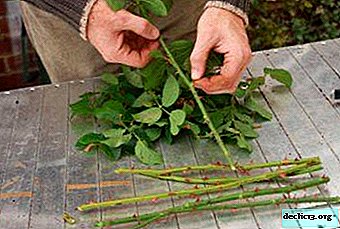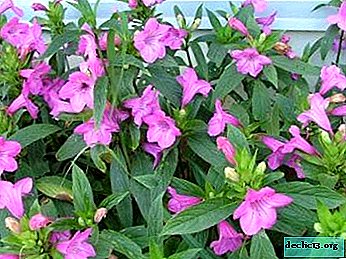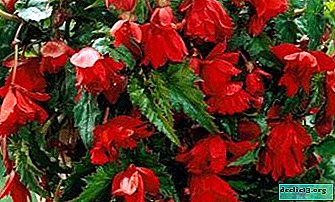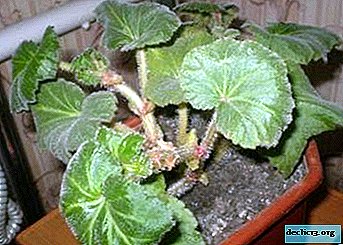Stunning rose Topaz - details about the appearance, care and reproduction. Flower photo

The classically beautiful Topaz rose flower will undoubtedly become an adornment of any summer cottage and looks great in bouquets.
For example, in Greece, the bride’s bouquet must include at least one rose of this variety, which symbolizes the brightness and richness of the future life.
In the article you will find interesting and useful information about the Topaz rose - you will learn in detail about the form, care and reproduction.
Detailed description and photo
Rosa Topaz belongs to the hybrid tea, that is, large-flowered varieties, and is distinguished by lush, dark green foliage, a straight stem and elongated goblet buds. It blooms large (up to 12 centimeters in diameter), double, bright pink with lilac shimmer flowers. The moderate, delicate aroma of the flower allows it to be used in bouquets even in rooms of a small area.
The advantages of a rose include a long flowering period throughout the summer, splendor - up to three buds on one shoot, and frost resistance, which allows even inexperienced gardeners to grow it.
It is necessary to carefully monitor the bush, as it has medium resistance to rain, and diseases such as powdery mildew and black spotting.In the photo you will see how this view looks:



History of selection and origin of the name
Topaz cultivar bred in Ecuador, a South American state leader in the cultivation and export of roses. In nature, these flowers grow in the fertile soil of the slopes of extinct volcanoes, which gives them a deep, rich color. And thanks to the abundance of light and direct sunlight, a slender strong stalk is formed. Breeders named the new Topaz variety, seeing in the flower a resemblance to a semiprecious stone - a classically beautiful bud, an amazing color and splendor of an inflorescence of a rose.
What is the difference from the rest of the pink species?
Due to the resistance of the petals to raking, and the ability of the buds to be fresh in cut for up to two weeks, this variety is especially popular with florists and flower growers who professionally grow flowers for cutting.
Bloom
When and how does it happen?
Rosa Topaz has a repeated type of flowering, that is, generously produces buds and blooms two to three times per season, almost the bush will be constantly showered with flowers from May to late autumn.
Care before and after
When the bush releases the buds, it can be fed with organic substances, such as peat or plant compost. Fresh manure should be avoided, as it can damage the roots of the plant.
If the rose blooms well, then additional nutrition during flowering is not required. In order for the bush to maintain a well-groomed appearance, it is necessary to prune dried flowers after withering.What to do if it does not bloom?
 Let's see why the rose may not bloom:
Let's see why the rose may not bloom:
- Bushes of the first year of planting may not bloom, it all depends on the condition of the seedling and on your actions in the process of planting and care. Moreover, some experienced gardeners recommend not letting young plants bloom so that they better take root in a new place.
- Wrong landing place. Roses, like southern plants, really need the sun, ideally at least 8 hours of direct light per day. Therefore, for landing, you need to choose the most open place.
- Incorrect pruning. In addition to annual pruning after flowering, and easy pruning in spring, it is imperative to cut dry flowers, if necessary, even daily.
- Not enough care. Rose bushes require a lot of attention, they must be additionally fed, sprayed from pests and fight diseases.
- Careless weeding. Roses are very sensitive to weeds, which take away water and nutrients from the soil.
- The plant will not give flowers in heavy soil. The landing site must be dug to a depth of about a meter and saturated with organic matter.
Use in landscape design
Landscape designers recommend tea-hybrid roses to be placed in the most prominent parts of the garden, because the richness of their color shades and classic shapes give the impression of grandeur, grace and nobility. Flowerbeds are better to use a rectangular shape, and do not mix several varieties on the same space. Near the roses blooming shrubs look great, which must be planted no closer than 1-1.5 meters, for example lilac, acacia, sea buckthorn.
The beauty of roses is also favorably highlighted not only by deciduous, but also evergreen coniferous shrubs, such as cotoneaster. It all depends on what effect you want to achieve - white color will give the rosary solemnity, shades of blue and green accentuate the beauty of individual flowers.
Step-by-step care instructions
Seat selection
Topaz roses need to be planted in the most open, sunny placeswhile trying to protect the flowers from the cold wind and draft.
Time
The best time for planting is mid-May, the main thing is that the earth is sufficiently heated.
What should be the soil?
The soil should be well moistened and saturated with air. The degree of acidity is neutral or slightly acidic, which corresponds to an indicator of 5.6-7.3 pH. Acidity can be adjusted using fertilizers containing calcium and magnesium.: ground limestone, slaked lime, chalk and wood ash.
Landing
 There are two ways to plant roses - seedlings, and grow them yourself from seeds. The second method is more time-consuming and requires careful monitoring at all stages.
There are two ways to plant roses - seedlings, and grow them yourself from seeds. The second method is more time-consuming and requires careful monitoring at all stages.
- We choose unripe fruits from the roses you like, as they have a better germination compared to dry ones.
- Cut the box into two parts and release the seeds from the pulp.
- We wash in a solution of hydrogen peroxide for 20 minutes.
- Further, the seeds are stratified until spring at home or in the garden.
- Before planting, the roots of the plant need to be immersed in water for 5-6 hours.
- We dig a trench about 50/50 cm in size, while it is important that the roots fit freely in it.
- At the bottom we fill up the drainage, then the prepared soil, fill with 2 liters of water and let it soak.
- We place a sapling in the middle, fall asleep, condense and spud with dry soil.
Temperature
The Topaz variety is quite frost-resistant and even short-term frosts up to -10 will not damage it.. The optimum temperature at which roses bloom beautifully is 17-20 degrees Celsius.
Watering
Watering the bushes is preferable in the evening. Young shoots are watered every 2-3 days, 3-4 liters per bush, a mature plant is enough to water once a week, but already 10 liters per bush. At temperatures above 25 degrees, it is advisable to add spraying to this.
Top dressing
 It is important to pay attention to the fact that young seedlings in the first year only need top dressing on leaves in the fall (one tablespoon of sulfate per 8 liters of water) to prepare for wintering.
It is important to pay attention to the fact that young seedlings in the first year only need top dressing on leaves in the fall (one tablespoon of sulfate per 8 liters of water) to prepare for wintering.
For plants in the spring, it is recommended to make mineral dry formulations, which can be alternated with organic substances.
After each feeding, let the plant rest for 10 days.so that it has time to absorb all the beneficial substances.
Weeding
Timely weekly weeding will save you from problems with a lack of water and nutrients that will devour weeds.
Pruning
To stimulate flowering, it is very important to remove wilted flowers and dried branches daily. Besides, in the spring and before winter carry out global pruning of the bush, removing all unhealthy, dry, damaged branches and shoots.
It is important to observe the direction of pruning to get a well thinned, evenly lit and beautifully shaped bush.Transfer
It is best to transplant a rose in early spring or late fallafter flowering. The bush is trimmed to 6 buds and transplanted, observing the conditions, as when planting young seedlings.
Preparation for winter
Roses Topaz must be covered for the winter, after pruning, careful weeding and inspection of the bush. Dry peat and fir spruce are best suited for these purposes.
How to propagate?
The easiest way to propagate roses is cuttings:
 Harvesting - when the buds are formed, cut off the shoot and make from the central part of the stalk, 5-8 cm long with 2-3 leaves. The lower edge should be under the kidney itself, and the upper one centimeter above the kidney.
Harvesting - when the buds are formed, cut off the shoot and make from the central part of the stalk, 5-8 cm long with 2-3 leaves. The lower edge should be under the kidney itself, and the upper one centimeter above the kidney.- Before planting for a day, put the stalk in the root stimulator. For example, in water with a teaspoon of honey.
- Plant in a box or soil, deepening by 2-3 cm, be sure to add the substrate of river sand and cover with a glass jar.
- After planting, maintain high humidity by spraying.
Diseases and Pests
Before the appearance of leaves, in the spring, as a prophylaxis against powdery mildew, a rose is sprayed with a solution of soda in a ratio of 40 g per liter of water.From green aphids effective solution of laundry soap, wormwood and water. After wintering under shelter, the stems of the plant must be carefully examined and cut affected by a bacterial burn.
With careful care and following the recommendations, Topaz roses will delight you with luxurious, fragrant flowers for more than one summer.
Useful video
We offer you to watch a video about Topaz tea-hybrid rose:

 Harvesting - when the buds are formed, cut off the shoot and make from the central part of the stalk, 5-8 cm long with 2-3 leaves. The lower edge should be under the kidney itself, and the upper one centimeter above the kidney.
Harvesting - when the buds are formed, cut off the shoot and make from the central part of the stalk, 5-8 cm long with 2-3 leaves. The lower edge should be under the kidney itself, and the upper one centimeter above the kidney.















